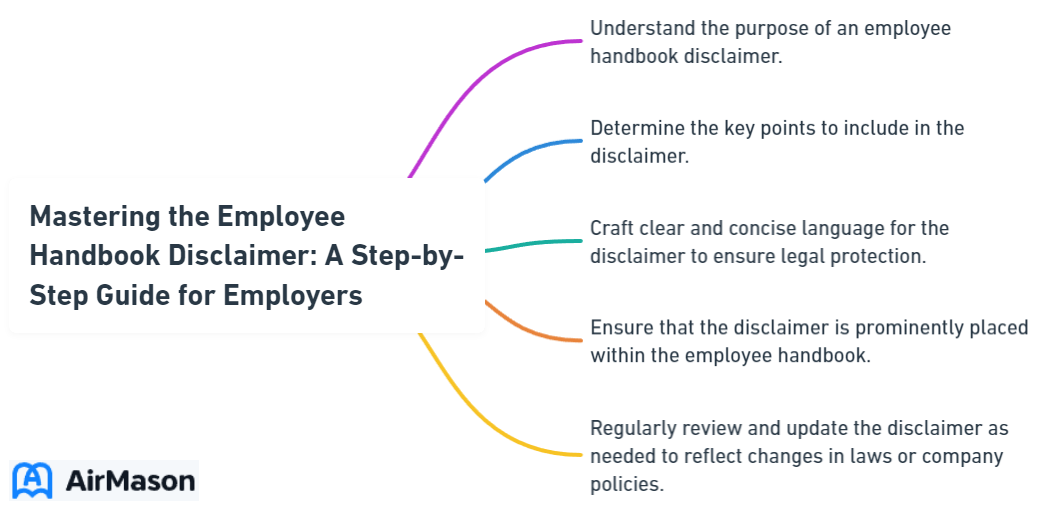
Crafting an employee handbook disclaimer is about clarity and protection—ensuring every team member understands the handbook is a guide, not a binding contract, and shielding the company from potential legal pitfalls. This article provides a direct roadmap to legally sound disclaimers that respect labor laws and fortify employer-employee understanding.
Key Takeaways
- Employee handbook disclaimers are crucial for legally safeguarding employers by clarifying that the handbook does not constitute an employment contract and emphasizing the at-will status of employment.
- A well-constructed disclaimer should include at-will employment language, clarify non-contractual obligations, assert the right to modify policies, and be tailored to comply with state-specific laws and industry-specific requirements.
- Employers should draft disclaimers using clear, simple language and with legal consultation, ensure regular updates for compliance, avoid ambiguity, and present them prominently, accompanying them with an acknowledgment form for employees.
Employee Handbook Orientation
Employee Handbook Orientation is a crucial aspect of onboarding new hires effectively. During this session, new employees are introduced to the company’s policies, procedures, and expectations outlined in the Employee Handbook. The orientation provides a comprehensive overview of the organization’s culture, values, and mission, ensuring that employees understand their roles within the broader context of the company. Additionally, it serves as an opportunity for employees to ask questions and seek clarification on any policies or guidelines they may find ambiguous. By familiarizing new hires with the Employee Handbook early on, companies can promote adherence to company policies and foster a positive work environment from the outset.
Understanding the Importance of Employee Handbook Disclaimers

Employee handbooks’ disclaimers act as a company’s protective shield, substantially diminishing liability claims’ risk by affording legal safeguards. Most importantly, a well-crafted disclaimer communicates that the most current version of the handbook supersedes all previous versions. This ensures that employees adhere to up-to-date policies, preventing the application of outdated rules and procedures.
Incorporating employment-at-will disclaimers into these legal safeguards holds significant importance. These disclaimers clarify that employment can be terminated at the discretion of the employer, protecting against claims of wrongful discharge. In essence, a comprehensive disclaimer serves as an essential tool in avoiding legal disputes and ensuring a harmonious working environment.
Legal Protection
At the heart of legal protection in disclaimers is the concept of at-will employment. This provision, safeguarding employers from wrongful discharge claims by employees, is of utmost importance. The law requires an acknowledgement form to contain language confirming that the employee’s role is at-will and that the handbook does not serve as a contract.
Certain states, like South Carolina, even require employee handbooks to include a disclaimer to avoid creating an implied contract of employment. It’s imperative to explicitly state in the disclaimer that the employee handbook neither creates an employment contract nor guarantees employment of any duration. This clarification helps prevent the formation of an implied contract and counters any assumptions of a guaranteed employment term.

Clear Expectations
Clear guidelines and expectations established through disclaimers are paramount in preventing legal disputes and misunderstandings between employers and employees. It is crucial to employ specific language in disclaimers to prevent employees from exploiting policy loopholes, while also providing the necessary flexibility to address unique circumstances.
Disclaimers play a vital role in granting company leaders the necessary autonomy to interpret and adjust policies. This flexibility is critical to keep policies relevant and fair across various situations. To ensure adherence to policies and identify ambiguous terms that may require updates, the disclaimer should encourage employees to address questions to the HR team.
Key Elements to Include in an Employee Handbook Disclaimer

Formulating an efficacious Employee Handbook Disclaimer necessitates a harmonious balance of key elements. Paramount among these is making it clear that the handbook is not an employment contract. A robust disclaimer also includes a general statement about the employer’s intent to respect protected rights under the National Labor Relations Act and specific statements in relevant policies.
A potent disclaimer needs to cover all necessary areas without deterring the reader due to excessive length. It should address:
- Compliance with local laws
- Industry-specific customization
- Modern workplace practices, such as technology shifts and legal provisions like FLSA Safe Harbor
At-Will Employment Status
At-will employment, a cornerstone of employment law in the United States, means that an at will employee:
- Can be terminated by an employer for any reason as long as it’s not illegal.
- Is allowed to resign from a job at any time, regardless of the reason.
- Has no restrictions on when they can choose to leave their position.
- Should find clarification in the employee handbook regarding this arrangement, stating the absence of any fixed terms or conditions of the employee’s employment.
The disclaimer in the handbook should highlight the at-will employment status, alerting employees that the handbook doesn’t imply an employment contract. It is also essential to seek legal advice to include specific language in the at-will employment disclaimer, ensuring compliance with applicable laws and addressing recognized exceptions.
Non-Binding Contract
In order to prevent any misconceptions, the employee handbook disclaimer should explicitly clarify that:
- The handbook is not a legally binding employment contract
- It is designed to ensure employees understand that the handbook does not establish any fixed terms and conditions of employment
- It does not create contractual obligations.
It should be clear in the disclaimer that:
- No manager or representative is authorized to enter into an employment agreement, except for a few high-level officers such as Senior Officers.
- Employment is not guaranteed for any specific duration, and we do not guarantee employment for anyone.
- Only formally written agreements signed by authorized Senior Officers are recognized as valid and binding.
When creating a legal disclaimer, it’s important to consider various disclaimer examples to ensure that all necessary points are emphasized effectively.
Right to Modify Policies
Moreover, the disclaimer should unequivocally declare the company’s right to alter, revise, or terminate policies, procedures, or employee benefit programs at their discretion, regardless of their mention in the handbook. This provision ensures that any new updates to the handbook supersede previous versions and policies, making the most current handbook the authoritative source.
Revising the handbook through disclaimers allows the company to incorporate relevant legislative changes and organizational adjustments without the need for continuous, costly revisions. To ensure employees are aware of these changes, employers should communicate handbook changes promptly, potentially using a handbook management system for ease of updating.
L’Brands Employee Handbook
The L’Brands Employee Handbook serves as a comprehensive guide for all employees within the organization. It outlines the policies, procedures, and expectations that govern the conduct and responsibilities of every individual associated with L’Brands. This handbook is designed to ensure clarity and consistency across all departments and levels of the company. Employees are encouraged to familiarize themselves with its contents to uphold the values and standards upheld by L’Brands. By adhering to the guidelines outlined in the L’Brands Employee Handbook, employees contribute to a positive and productive work environment while promoting the company’s mission and goals.
Crafting Effective Disclaimers: Tips and Best Practices

Crafting an efficacious disclaimer entails more than merely incorporating the right elements. It also demands a mindful consideration of aspects like language choice, legal consultation, and maintaining consistency. For instance, the disclaimer should clearly communicate that the employee handbook is subject to change, and avoid any language that could imply an employment contract.
To ensure immediate visibility, place the handbook disclaimer as the first item in the handbook. The disclaimer should also direct employees on how to seek further help or clarification regarding the handbook’s policies. To enhance effectiveness and ensure it addresses specific business needs and compliance requirements, consider using a generator to create a tailored disclaimer.
Simple Language
Employing simple and direct language in disclaimers assures their clarity and straightforwardness, resulting in comprehension among all employees. Clear and unambiguous language in disclaimers prevents misinterpretation, ensuring employees are aware of their at-will employment status and the non-contractual nature of the handbook.
The ultimate goal of the disclaimer is to be easily understandable by all employees, which is achieved through the use of clear, easy-to-understand words.
Legal Consultation
Considering the complexity of employment laws that differ across states and jurisdictions, it’s pivotal to seek legal advice during the formulation of an employee handbook disclaimer. Consulting with legal counsel ensures the disclaimer complies with legal requirements and meets the specific needs of your company.
Legal experts are especially crucial when operating in heavily regulated industries or areas with significant liability concerns, such as providing investment advice. Consulting legal counsel ensures that the language in the disclaimer does not inadvertently establish an implied contract, which could legally bind the employer.
Consistency
Maintaining consistency plays a significant role in creating efficacious disclaimers. Consistency between the disclaimer and the handbook’s policies prevents misunderstandings that could lead to legal disputes. Disclaimers enable employers to adapt policies to local needs and conditions, offering the necessary flexibility to interpret policies based on varying circumstances.
Regular updates to the employee handbook ensure that employees have access to the most up-to-date policies, with the latest version superseding all previous ones. A consistent employee handbook is a reliable reference for employees to understand expectations for their behavior, performance, and conduct, facilitating clear communication.
Examples of Well-Written Employee Handbook Disclaimers

Drawing insights from examples can prove invaluable in formulating potent disclaimers. For instance, a comprehensive employee handbook disclaimer includes an acknowledgment of employee responsibilities, like XYZ Company’s: ‘I understand that I am responsible for reading the handbook, familiarizing myself with its contents, and adhering to all of the policies and procedures of XYZ Company, whether set forth in this handbook or elsewhere.’
Requesting an acknowledgment signature from employees, as practiced in XYZ Company’s handbook, confirms that they have read and understood the handbook contents. Effective disclaimers define the non-contractual nature of the handbook, as exemplified by XYZ Company: ‘The policies, procedures and standard practices described in this manual are not conditions of employment.’
Avoiding Common Pitfalls in Employee Handbook Disclaimers
Being cognizant of common pitfalls is essential while formulating a disclaimer. It is important to avoid using generic disclaimers; instead, tailor the employee handbook disclaimer to address the specific operations, culture, and policies of your business.
Also, ensure the disclaimer allows for flexibility in disciplinary actions, enabling the management to adapt to various situations on a case-by-case basis.
Overlooking State-Specific Laws
Disregarding state-specific laws can result in non-compliance and ensuing legal complications. For multi-state employers, it is essential that handbook disclaimers recognize the need for variations in policy application in accordance with local laws, directing employees to seek further clarification when needed.
Termination laws vary by state, necessitating employers to understand and comply with different rules, such as notice period requirements and laws governing the provision of termination reasons in each state where they operate. For instance, California’s termination laws exemplify the complex layers of employee protection that must be considered by employers to avoid wrongful termination suits.
Ambiguity
Ambiguity in disclaimers can cause confusion and potential legal disputes. To prevent this, employee handbooks should utilize straightforward language that is easily understood. Policies in the handbook should steer clear of wording that could be construed as creating contractual commitments.
The disclaimer should assert that the employee handbook does not encompass every specific instance or exception to general policies to prevent confusion over its comprehensiveness.
Neglecting Updates
Ignoring updates may lead to obsolete or erroneous information, which can cause non-compliance with legal norms. Regular reviews and updates to the employee handbook and disclaimer are critical to maintain consistency with changes in company policies, best practices, or legal requirements.
Changes in business operations, products, services, and relevant laws necessitate updates to the employee handbook disclaimer to ensure its relevance and legal compliance. An updated disclaimer should clearly state that it supersedes all previous versions, ensuring no confusion regarding the application of the most current handbook terms.
Implementing Disclaimers in Your Employee Handbook

The implementation of disclaimers in the employee handbook extends beyond mere writing. The design and accessibility of the disclaimer page are important; it should be easy to find, comprehend, and positioned where it can’t be missed to fulfill its protective purpose effectively.
The disclaimer should be placed prominently in the employee handbook, ideally below the cover page to ensure it is seen by employees. To confirm employees’ understanding and responsibility to read and seek clarification on policies, the disclaimer should be accompanied by an acknowledgment form for employees to sign.
Best Buy Employee Policy
Best Buy employee policy outlines the guidelines and expectations for all staff members. It encompasses various aspects such as working hours, conduct, and benefits. Employees are required to adhere to this policy to maintain a positive work environment and ensure customer satisfaction. The policy also addresses issues related to confidentiality, safety regulations, and career development opportunities. By following the Best Buy employee policy, both the company and its employees can thrive in a mutually beneficial relationship.
Summary
Throughout this blog post, we’ve delved into the importance of Employee Handbook Disclaimers, how to craft them effectively, and common pitfalls to avoid. We’ve discussed how disclaimers serve as legal protection for companies and set clear expectations for employees, reducing the risk of disputes and liabilities.
Remember, disclaimers are more than just a formality. They are your company’s safeguard, a tool for setting clear expectations, and a guide for your employees. Making the effort to understand and craft effective disclaimers is an investment in the long-term success and harmony of your workplace.
Frequently Asked Questions
What is a disclaimer in an employee handbook?
A disclaimer in an employee handbook is a statement that denies the handbook’s status as an employment contract and specifies that the company is not obliged to provide employment based on the handbook’s contents.
What is legally required in an employee handbook?
In an employee handbook, it is legally required to cover aspects such as minimum wage regulations, anti-discrimination policies, safety regulations, time off policies, and more. Additionally, it should include the employer’s mission statement, equal employment opportunity statement, contractual disclaimer, and company background information.
What should be avoided in an employee handbook?
Avoid overlooking legal obligations, neglecting federal, state, and local laws, and forgetting to include information on leaving the company, resignations, terminations, and retirements.
Why are disclaimers important in an employee handbook?
Disclaimers in an employee handbook are important as they serve as a legal safeguard for companies, reducing the risk of exposure to liability claims and setting clear expectations for employees.
What are the key elements to include in an employee handbook disclaimer?
Make sure to include the at-will employment status, the non-binding nature of the handbook, and the company’s right to modify policies in your employee handbook disclaimer. These elements are crucial for setting clear expectations and protecting the company from legal liabilities.
Important Disclaimer:
Please be aware that the content on this page has been generated by using artificial intelligence language models and may contain errors, inconsistencies, or outdated information. It is provided as-is without any warranties or guarantees of accuracy.
We strongly recommend using this content as a starting point for further research. We disclaim any liability for damages or losses resulting from the use or reliance on this content.